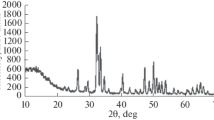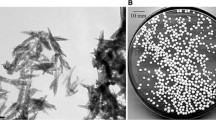Abstract
Elemental and phase composition of hydroxyapatite (HA) nanoparticle surface with absorbed zirconium were studied with X-ray photoelectron spectroscopy. Zr4+ adsorption on HA nanocrystals as a function of hydrochloric solution pH was established. The mechanism of interaction of zirconium with the HA surface was discussed. The obtained results are fundamental for 89Zr-based radiopharmaceuticals with a new design.






Similar content being viewed by others
References
Chu SYF, Ekström LP, Firestone RB. WWW table of radioactive isotopes. In: Database version 1999-02-28
Deri MA, Zeglis BM, Francesconi LC, Lewis JS (2013) PET imaging with89Zr: from radiochemistry to the clinic. Nucl Med Biol 40:3–14. https://doi.org/10.1016/j.nucmedbio.2012.08.004
Moek KL, Giesen D, Kok IC et al (2017) Theranostics using antibodies and antibody-related therapeutics. J Nucl Med 58:83S–90S. https://doi.org/10.2967/jnumed.116.186940
Rice SL, Roney CA, Daumar P, Lewis JS (2011) The next generation of positron emission tomography radiopharmaceuticals in oncology. Semin Nucl Med 41:265–282. https://doi.org/10.1053/j.semnuclmed.2011.02.002
Jauw YW, der Houven Menke-van, van Oordt CW, Hoekstra OS et al (2016) Immuno-positron emission tomography with zirconium-89-labeled monoclonal antibodies in oncology: what can we learn from initial clinical trials? Front Pharmacol 7:1–15. https://doi.org/10.3389/fphar.2016.00131
van de Watering FCJ, Rijpkema M, Perk L et al (2014) Zirconium-89 labeled antibodies: a new tool for molecular imaging in cancer patients. Biomed Res Int 2014:1–13. https://doi.org/10.1155/2014/203601
Heskamp S, Raavé R, Boerman OC et al (2017) 89 Zr-immunoPET in oncology: state of the art 89 Zr-radiochemistry. Bioconjug Chem. https://doi.org/10.1021/acs.bioconjchem.7b00325
Jansen MH, Veldhuijzen van Zanten SEM, van Vuurden DG et al (2017) Molecular drug imaging: 89 Zr-bevacizumab PET in children with diffuse intrinsic pontine glioma. J Nucl Med 58:711–716. https://doi.org/10.2967/jnumed.116.180216
Price EW, Carnazza KE, Carlin SD et al (2017) 89 Zr-DFO-AMG102 immuno-PET to determine local hepatocyte growth factor protein levels in tumors for enhanced patient selection. J Nucl Med 58:1386–1394. https://doi.org/10.2967/jnumed.116.187310
van Es SC, Brouwers AH, Mahesh SVK et al (2017) 89 Zr-bevacizumab PET: potential early indicator of everolimus efficacy in patients with metastatic renal cell carcinoma. J Nucl Med 58:905–910. https://doi.org/10.2967/jnumed.116.183475
Holland JP, Sheh Y, Lewis JS (2009) Standardized methods for the production of high specific-activity zirconium-89. Nucl Med Biol 36:729–739. https://doi.org/10.1016/j.nucmedbio.2009.05.007
Severin GW, Jørgensen JT, Wiehr S et al (2015) The impact of weakly bound89Zr on preclinical studies: non-specific accumulation in solid tumors and aspergillus infection. Nucl Med Biol 42:360–368. https://doi.org/10.1016/j.nucmedbio.2014.11.005
Krasikova RN, Aliev RA, Kalmykov SN (2016) The next generation of positron emission tomography radiopharmaceuticals labeled with non-conventional radionuclides. Mendeleev Commun 26:85–94. https://doi.org/10.1016/j.mencom.2016.03.001
Ciarmatori A, Cicoria G, Pancaldi D et al (2011) Some experimental studies on 89Zr production. Radiochim Acta 99:631–634. https://doi.org/10.1524/ract.2011.1822
Degering D, Unterricker S, Stolz W (1988) Excitation function of the 89Y(d,2n)89Zr reaction. J Radioanal Nucl Chem Lett 127(1):7–11
Kandil SA, Scholten B, Saleh ZA et al (2007) A comparative study on the separation of radiozirconium via ion-exchange and solvent extraction techniques, with particular reference to the production of 88 Zr and 89 Zr in proton induced reactions on yttrium. J Radioanal Nucl Chem 274:45–52. https://doi.org/10.1007/s10967-006-6892-2
Zweit J, Downey S, Sharma HL (1991) Production of no-carrier-added zirconium-89 for positron emission tomography. Int J Radiat Appl Instrum Part A Appl Radiat Isot 42:199–201. https://doi.org/10.1016/0883-2889(91)90074-B
Kasbollah A, Eu P, Cowell S, Deb P (2013) Review on production of 89Zr in a medical cyclotron for PET radiopharmaceuticals. J Nucl Med Technol 41:35–41. https://doi.org/10.2967/jnmt.112.111377
Perk LR, Visser OJ, Stigter-Van Walsum M et al (2006) Preparation and evaluation of 89Zr-Zevalin for monitoring of 90Y-Zevalin biodistribution with positron emission tomography. Eur J Nucl Med Mol Imaging 33:1337–1345. https://doi.org/10.1007/s00259-006-0160-0
Pandya DN, Pailloux S, Tatum D et al (2015) Di-macrocyclic terephthalamide ligands as chelators for the PET radionuclide zirconium-89. Chem Commun 51:2301–2303. https://doi.org/10.1039/C4CC09256B
Meshkini A, Oveisi H (2017) Methotrexate-F127 conjugated mesoporous zinc hydroxyapatite as an efficient drug delivery system for overcoming chemotherapy resistance in osteosarcoma cells. Colloids Surf. B Biointerfaces 158:319–330. https://doi.org/10.1016/j.colsurfb.2017.07.006
Perez-Medina C, Tang J, Abdel-Atti D et al (2015) PET imaging of tumor-associated macrophages with 89Zr-labeled high-density lipoprotein nanoparticles. J Nucl Med 56:1272–1277. https://doi.org/10.2967/jnumed.115.158956
Perez-Medina C, Abdel-Atti D, Zhang Y et al (2014) A modular labeling strategy for in vivo PET and near-infrared fluorescence imaging of nanoparticle tumor targeting. J Nucl Med 55:1706–1711. https://doi.org/10.2967/jnumed.114.141861
Li N, Yu Z, Pham T et al (2017) A generic 89Zr labeling method to quantify the in vivo pharmacokinetics of liposomal nanoparticles with positron emission tomography. Int J Nanomed 12:3281–3294. https://doi.org/10.2147/IJN.S134379
Zhao Y, Shaffer TM, Das S et al (2017) Near-infrared quantum dot and 89 Zr dual-labeled nanoparticles for in vivo Cerenkov imaging. Bioconjug Chem 28:600–608. https://doi.org/10.1021/acs.bioconjchem.6b00687
Karmani L, Labar D, Valembois V et al (2013) Antibody-functionalized nanoparticles for imaging cancer: influence of conjugation to gold nanoparticles on the biodistribution of 89 Zr-labeled cetuximab in mice. Contrast Media Mol Imaging 8:402–408. https://doi.org/10.1002/cmmi.1539
Cheng L, Kamkaew A, Shen S et al (2016) Facile preparation of multifunctional WS2/WOx nanodots for chelator-free 89 Zr-labeling and in vivo PET imaging. Small 12:5750–5758. https://doi.org/10.1002/smll.201601696
Kolmas J, Krukowski S, Laskus A, Jurkitewicz M (2016) Synthetic hydroxyapatite in pharmaceutical applications. Ceram Int 42:2472–2487. https://doi.org/10.1016/j.ceramint.2015.10.048
Orlova MA, Nikolaev AL, Trofimova TP et al (2019) Hydroxyapatite and porphyrin-fullerene nanoparticles for diagnostic and therapeutic delivery of paramagnetic ions and radionuclides. Bull Russ State Med Univ. https://doi.org/10.24075/brsmu.2018.075
Vasiliev AN, Severin A, Lapshina E et al (2017) Hydroxyapatite particles as carriers for 223Ra. J Radioanal Nucl Chem 311:1503–1509. https://doi.org/10.1007/s10967-016-5007-y
Severin AV, Pankratov DA (2016) Synthesis of nanohydroxyapatite in the presence of iron(III) ions. Russ J Inorg Chem 61:265–272. https://doi.org/10.1134/s0036023616030190
Melikhov IV, Komarov VF, Severin AV (2000) Two-dimensional crystal hydroxyapatite. Rep Russ Acad Sci 373:355 (In Russian)
Shirley DA (1972) High-resolution X-ray photoemission spectrum of the valence bands of gold. Phys Rev B 5:4709–4714. https://doi.org/10.1103/PhysRevB.5.4709
Panov AD (1997) Packet of programs of spectra processing SPRO and programming language SL. Prepr Inst At Energy, Moscow, IAE-6019/15 31
Nemoshkalenko VV (1976) Electron spectroscopy of crystals. Naukova Du, Moscow
Sosulnikov MI, Teterin YA (1992) X-ray photoelectron studies of Ca, Sr and Ba and their oxides and carbonates. J Electron Spectros Relat Phenomena 59:111–126. https://doi.org/10.1016/0368-2048(92)85002-O
Maslakov KI, Livshits TS, Lapina MI et al (2007) An X-ray photoelectron study of the (Ca2.5Th0.5)Zr2Fe3O12, (Ca1.5GdTh0.5)(ZrFe)Fe3O12, and (Ca2.5Ce0.5)Zr2Fe3O12 ceramics with a garnet structure. Radiochemistry 49:33–40. https://doi.org/10.1134/s1066362207010067
Nefedov VI (1985) X-ray spectroscopy of chemical compounds. Himiya, Moscow
Trzhaskovskaya MB, Yarzhemsky VG (2018) Dirac–Fock photoionization parameters for HAXPES applications. At Data Nucl Data Tables 119:99–174. https://doi.org/10.1016/j.adt.2017.04.003
Smith DK, Newkirk HW (1965) The crystal structure of baddeleyite (monoclinic ZrO2) and its relation to the polymorphism of ZrO2. Acta Crystallogr 18:983–985
Acknowledgements
The authors acknowledge support from Lomonosov Moscow State University Program of Development for providing access to the XPS facility. The work was partially supported by the RFBR Grants 18-33-00649 and 17-03-00277a.
Author information
Authors and Affiliations
Corresponding author
Additional information
Publisher's Note
Springer Nature remains neutral with regard to jurisdictional claims in published maps and institutional affiliations.
Rights and permissions
About this article
Cite this article
Teterin, Y.A., Kazakov, A.G., Teterin, A.Y. et al. The study of Zr adsorption on nanodispersed hydroxyapatite: X-ray photoelectron study. J Radioanal Nucl Chem 321, 341–347 (2019). https://doi.org/10.1007/s10967-019-06586-7
Received:
Published:
Issue Date:
DOI: https://doi.org/10.1007/s10967-019-06586-7




